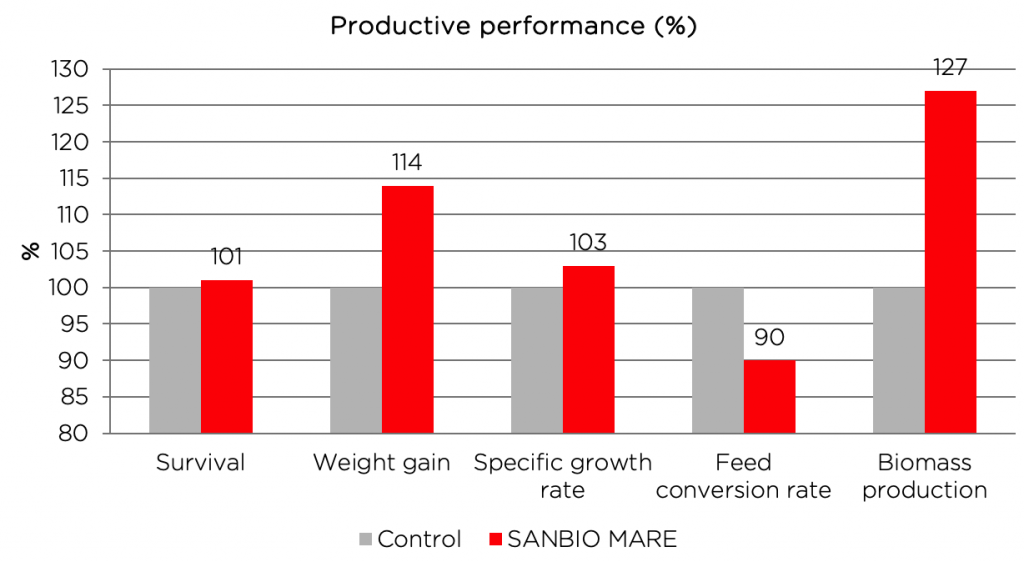Gutenborn, Germany (October 13, 2011) – Rainbow trout was one of the first species whose life cycle was fully replicated under farmed conditions. It can be farmed in a variety of systems, in many areas around the world and in both freshwater and seawater, making it one of the most popular species in aquaculture. Globally some 814,000 tonnes of rainbow trout were produced in 2010.
The objective of the trial what to evaluate the efficiency of functional feed Sanbio MARE added to normal diets for Rainbow Trout fed compared to similar diets but without addition of Sanbio MARE. The trial was performed according to the Best Practice Guideline by targeting the sensitive parameter (mortality, weight gain, feed intake, feed conversion rate).
The SANBOS GmbH, in cooperation with local partners, conducted a tank feeding trial with Rainbow Trout (Onchorhynchus mykiss). The objective of the trial was to demonstrate the growth and performance in fresh-water tanks with a partial replacement of fish feed by the functional feed Sanbio MARE.
1. Materials and methods
Four tanks of average size 2.5 m3 (underwater volume) were used for the feeding trial. Tanks were constructed of concrete.
Fish were 15 g Rainbow Trout produced locally in Germany. Rainbow Trout were stocked in the four trial tanks at a density of 170 fish per tank. Fish in all four trial tanks were of uniform size, age and health status at stocking.
Rainbow Trout in the control tank were fed with 100% of standard growout feed in extruded, floating pellet form as per Table 1.
Rainbow Trout in treated trial tanks were fed with 80% of standard growout feed in extruded, floating pellet form as per Table 1 and 20% of Sanbio MARE as per Table 2.
Fish were fed to satiation twice daily, with fish in all four tanks fed identically at every feeding.
Feed pellet size was increased as the fish grew so that the maximum size pellet that all fish could consume was being fed.
Fish were fed to satiation twice daily, with fish in all four tanks fed identically at every feeding. Feed pellet size was increased as the fish grew so that the maximum size pellet that all fish could consume was being fed.
Trial management was based on the best practice standards.
Fish in all tanks were sampled once per month on approximately the same date each month.
At the conclusion of the trial, all tanks were emptied and the fish in each tank counted and weighed to determine average fish weight, gross and net production, feed conversion ratio (FCR) and survival. Production input costs were recorded throughout the trial and net income and return on investment (ROI) were calculated at the end of the trial.
Table 1. Formula for the standard fish feed used in the trial
| Pellet size (mm) | 3 / 4.5 |
| Crude protein (%) | 46 |
| Crude fat (%) | 25 |
| NFE (%) | 9.4 |
| Ash (%) | 12.4 |
| Fibre (%) | 1.2 |
| P (%) | 1 |
| Gross energy (MJ) | 22.5 |
| Digestible energy (MJ) | 20.5 |
Table 2. Formula for the “Sanbio SANA” fish feed supplement used in the trial
| Pellet size (mm) | 3 |
| Crude protein (%) | 40 |
| Crude fat (%) | 10 |
| Ash (%) | 8 |
| Fibre (%) | 4.7 |
| P (%) | 1.5 |
| Amino acids | 5 |
| Vitamins | 1 |
| Carbohydrates | 5 |
| Minerals | 5 |
| Formate | 2.5 |
| Gross energy (MJ) | 22 |
| Digestible energy (MJ) | 18 |
2. Results
Rainbow Trouts were fed a total of 390 days. Rainbow Trouts grew from 15 g to an average weight of 670 g (+14% compared to control) during this feeding period.
Gross production averaged 128.58 kg per tank (+27% compared to control). Average Rainbow Trout survival rate was 99% (+11% compared to control). Average FCR for Rainbow Trout was 0.99 (-10% compared to control).
Table 3. Productive performance
| Cage no. | Unit | 1 | 2 | 3 | 4 | Average 2/3/4 |
| Cage | Control | Trial 1 | Trial 2 | Trial 3 | ||
| No day fed | D | 390 | 390 | 390 | 390 | |
| Stocking rate | Fish/tank | 170 | 170 | 170 | 170 | 170.00 |
| Harvest rate | Fish/tank | 151 | 168 | 168 | 168 | 168.3 |
| Mortality | % | 11 | 1 | 1 | 1 | 1.00 |
| Survival | % | 89 | 99 | 99 | 99 | 99.00 |
| Fish stocking weight | g | 15 | 15 | 15 | 15 | 15 |
| Fish harvest weight | g | 671 | 769 | 762 | 761 | 764 |
| Weight gain | g | 656 | 754 | 746 | 746 | 748.7 |
| Specific growth rate | SGR | 0.97 | 1.01 | 0.99 | 1.01 | 1.00 |
| Production | kg/tank | 101.5 | 129.4 | 128.2 | 128.1 | 128.58 |
| kg/m3 | 12.7 | 16.2 | 16.0 | 16.0 | 16.07 | |
| Feed intake | kg/tank | 112 | 124 | 130 | 127 | 126.86 |
| FCR | 1.1 | 0.96 | 1.01 | 0.99 | 0.99 |

Figure 1. Productive performance (%)
3. Conclusion
To summarize, the present study shows significantly positive effects of SANBIO MARE at the dosage of 20% of diet on productivity.
The positive effects at a glance:
- Reduction of mortality
- Increase of weight gain
- Improvement of FCR
- Positive effects on health status
- Safety and tolerance when used dietary additions.